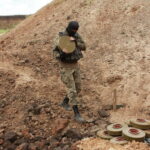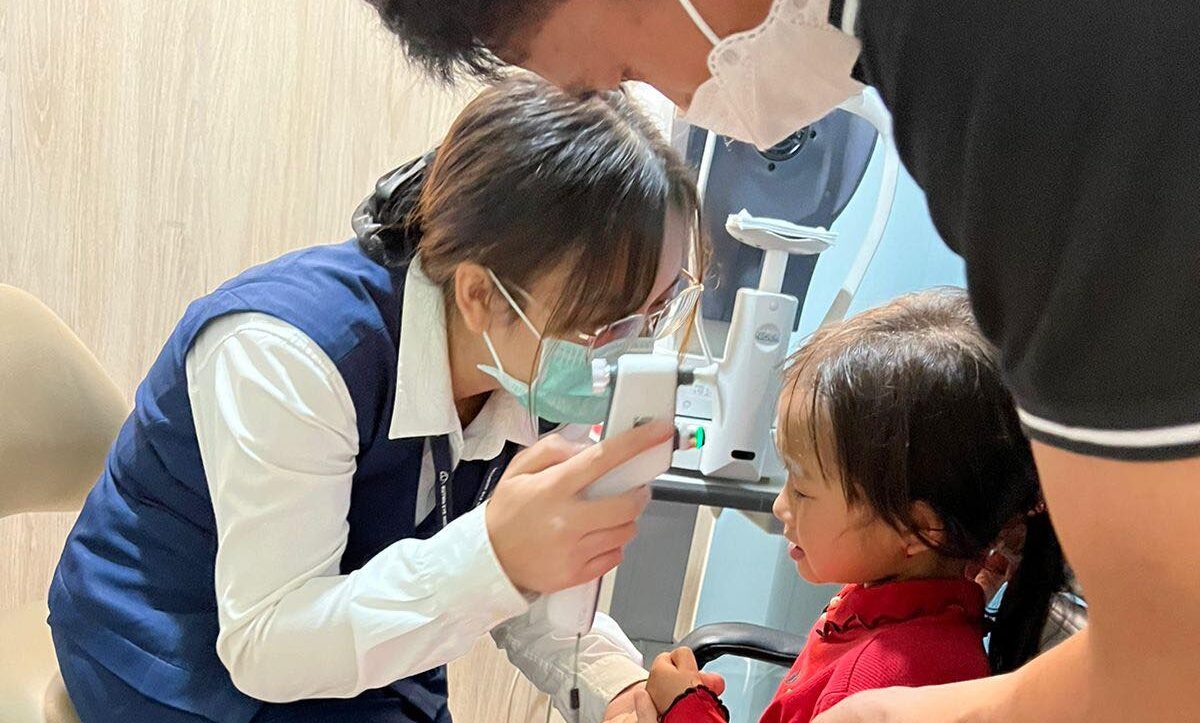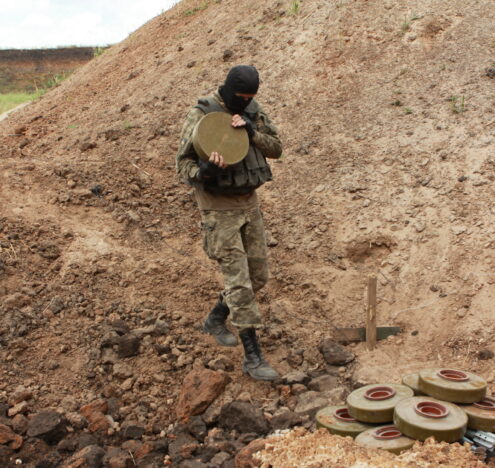The air was hot and muggy. My colleague and I were surrounded by so many bodies, all trying to coax a breeze into the shared hospital room with makeshift fans. Each patient was encircled by two or three family members who were diligently doing the work of lay nurses: changing bed sheets, giving medications, and providing wound care.
It was February 2024 and I was visiting a victim of an unexploded ordnance (UXO) accident in the hospital in Vientiane Capital. I work as the Country Director for World Education in Laos and oversee multiple projects related to UXO, including community inclusion projects for people with disabilities, education projects to enhance the prevention of UXO accidents, and a direct victims assistance project to support the medical needs of survivors. My background is in nursing, and in busy central hospitals where doctors and nurses are overworked and understaffed, patients can get overlooked, so I tend to pay special attention to the UXO victims currently in the hospital.
We sat with Ton,* a 16-year-old woman who had just had a traumatic brain injury as a result of UXO. We were trying to explain to her mother why she was not a candidate for surgery. When doctors do not have the time to talk to patients, this job comes to us. We are the ones that take the questions, explain the options and advocate for the best possible outcome for UXO survivors.
As I discussed the CT scan results with the young woman and her mother, I struggled to find the correct word in Lao so I looked up to ask for help and saw that my colleague was on the phone. Our eyes met and I immediately knew something was wrong. She hung up and whispered, “Another accident. Four boys involved in a UXO explosion. Two dead, a 10-year-old and a 14-year-old.”
As a mother, I immediately imagined what these boys’ mothers must have been feeling at that moment. To lose a child is to lose part of one’s heart. My heart ached for them, for their families, and for their entire communities. Young boys, the future leaders of their villages, lost. Two more casualties of a war long gone.
Two more kids to add to my list. My never-ending list.
It is not just a list of names and cold facts.
It is a list of souls.
A list of lost potential.
A list of love and a list of love lost.
I put the list out of my mind and chose to focus on the patient in front of me. “Do what you can do now Rebecca,” I told myself.
The Afterlives of UXOs
The last recorded American bombs fell on Laos in 1973. After a nine-year carpet bombing campaign, Laos was marked as the most bombed country per capita in history. Today, over 50 years later, millions of unexploded cluster munitions and other ordnance remain, holding hostage the land and the futures of children and their families. While the immense amount of bomb contamination left behind can be difficult to comprehend, it is relentlessly manifested in my work as my team responds to UXO accidents in all 17 provinces of Laos. UXO accidents still injure and kill over 300 people per year, according to Laos’ National Regulatory Authority for UXO and Mine Action.
World Education, a division of JSI, has supported more than 1,000 UXO survivors for their emergency and ongoing medical costs through the long-term commitment to support Victims of UXO from the US State Department’s Office of Weapons Removal and Abatement.
Continued American aid toward the UXO crisis in Laos has largely been spurred by the efforts of Legacies of War, a Lao American-founded and led organization, to raise awareness with the US Congress and constituents. In a landmark moment in 2016, President Obama became the first sitting US President to visit Laos. This visit led to the establishment of the Comprehensive Partnership between Laos and the US, addressing ten key areas including the legacies of war issues. The US is the largest funder of global demining and has allocated over $360 million allocated to demining activities in Laos since 1995. But this pales in comparison to the at least $50 billion the US spent to bomb Laos from 1964-1973.
The growing count of UXO survivors, with over half of all accidents involving children under the age of 18, requires aid that is beyond current US funding levels. We need increased support for long-term solutions that will support child survivors as they experience difficulties in school, in vocational training, and the challenges of finding employment with a disability. It is critical that the humanitarian mine action sector and American voters continue to urge the US to afford this crisis the attention and funding it requires.
A Focus on Youth
In early 2024, Ton survived an explosion in which shrapnel was lodged in several places of her brain, causing a Traumatic Brain Injury (TBI). Her case required intensive support, from multiple emergency surgeries to remove the fragments, to physical therapy to help her walk, and speech therapy assessments to help her learn to talk again. She is now home, but is struggling with her mental health and future within the limitations she now faces as a person with a TBI in a country with limited healthcare support. Unfortunately, due to the limited mental health services, vocational training and other safety nets available in Laos, there are very few systems in place to support her moving forward.
Children like her who are exposed to life-altering traumatic injuries require long-term solutions for physical, psychosocial, and vocational support throughout adulthood. Ensuring that victims are able to complete school and find jobs that are possible within the limitations imposed by their UXO injuries is particularly critical given their resource-limited environment. For example, a child who has lost a foot to UXO is unlikely to be a successful farmer and so needs alternative livelihoods. Such options are not yet available given the lack of safety nets currently within the Lao context.
Filling the Gaps in Care
In light of the lifelong ramifications of Explosive Ordnance/Explosive Weapons (EO/EW) injuries for victims, initiatives such as the United States Medical Fund for UXO — which provides direct financial support for medical care, follow up care and funeral costs — are critical. Yet, victim assistance in mine action has historically been heavily focused on long-term rehabilitation and socioeconomic reintegration, but not meeting other safety net gaps that are present in countries like Laos.
At present, nearly 40% of victims do not survive their injuries, according to independent epidemiologic analyses of EO casualties. At military treatment facilities and in high-resource civilian trauma centers, the mortality rate among even severely blast-injured patients ranges from approximately 2 to 8%. This gap points to the fact that a significant number of EO casualties are dying of preventable causes (such as airway obstruction or extremity hemorrhage) for reasons including the remote environments in which most EO incidents occur, the limited organized prehospital trauma care present in these environments, and the prolonged transport times to reach a health facility. There are ample opportunities to address these gaps. Things like layperson first responder trainings, investments in organized layperson transport systems, and trauma care trainings for prehospital and health facility personnel on damage control resuscitation and surgery for complex blast injuries. Local partnerships with the healthcare personnel who are on the frontlines of this issue are critical.
The List
I return to my list and add yet another name. While I know that this list will continue to grow, I have also started to keep another list. A list of those whose hope for a future has been restored. Despite the challenges that UXO survivors face, they are incredibly resilient, especially the kids.
On a recent trip to southern Laos, the WE team met with two boys who had been in an accident in 2023. The boys eagerly shared that they were back in school and excited about the upcoming Lao New Year celebrations. When looking at these boys, you would not know they had recently undergone a traumatic injury. Only the scars that covered their abdomens, well-hidden by their faded t-shirts, would give away their past.
Noy,* was a vibrant 10-year-old boy who loved playing ball, but after his UXO accident, he had pieces of shrapnel limiting the movement in his hands and he was unable to play. After the WE team brought him to a specialist, all the pieces were removed and he was back to playing ball within a few days.
As we approach International Youth Day this year, we must work harder to prioritize the safety of our youths from UXO in Laos and all countries impacted by legacy ordnance. Despite the odds, the children who have been injured from explosives have shown great courage and a hopeful outlook on life. Their bravery and stories of resiliency remind us that with the right amount of support, all UXO survivors can live extraordinary lives, contributing to their families and being an integral part of their communities. Let’s ensure that this is possible for our future generations.
*Children are identified by nicknames at their families’ request.
Cover image: 8-year-old Pan receiving eye assessments after being struck by a UXO in 2023




















